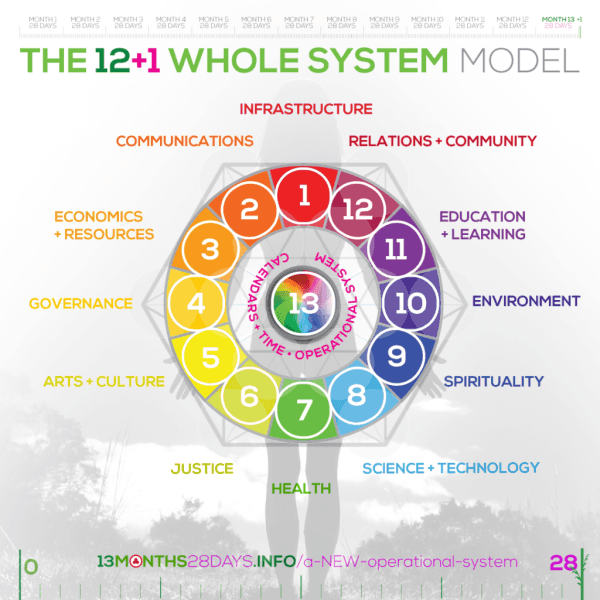The calendar we use is chaotic and inconsistent, yet most of us rarely question it. We rely on devices to track time, adjusting for leap years and daylight savings without a second thought. But what if this flawed system is causing confusion and disconnection from nature? Perhaps it’s time to reconsider how we measure and experience time.
. . .
Our most popular and widely used modern calendar is all screwed up, to put it mildly. This is seemingly by design, as it is just one of many material aspects in our realm that keep humans confused, out of alignment with nature, and wondering who, where, and when we are. There are no fewer than 34 different types of calendars in use across the realm to this day.
For us in the Western world, the beginnings of truth are in plain sight. If we examine the Latin meanings of what are currently accepted as the last four months of the year:
- September: Septem – Seven
- October: Octo – Eight
- November: Novem – Nine
- December: Decem – Ten
Why do we act as if these are the 9th, 10th, 11th, and 12th months? Because we’ve been living with the lie for so long that it’s now normal — even though a few seconds of critical thinking could unravel the entire nature of how we experience a year, now and forevermore.
If we are to rely on the sun as our means of calendrical measurement, it seems wise to adhere to a solar calendar. In this regard, the Persians, as well as adherents of the Baháʼí faith, may have it right. However, while most of us are accustomed to beginning our day in the morning, for those who follow solar calendars, the day begins at sunset and ends at sunset the following solar day. This is the same for Judaism and Islam. Therefore, according to the natural observable cycle, the new year begins with the Vernal, or Spring Equinox. Nature confirms this as the blossoms, flowers, grasses, trees, and life all around us burst forth in renewed and refreshed expression after Winter’s rest and slumber. The equinox (aequus + nox) signifies what is clearly observable: equal hours of daylight and equal hours of night.
How can it in any way be useful or accurate to consider January 1st as the first day of the year? It’s clearly not, and nature agrees with that assertion. Our days are only beginning to get longer shortly after the Winter Solstice, and midwinter is hardly a time of renewal and rebirth. It is a time for rest, reflection, integration, restoration, and recapitulation. The first day of January has, quite literally, nothing to do with a “New Year” — at least not until the “ancient” Romans decided it did.
In actuality, January is the 11th month, and February is the 12th, added to our calendar by the same aforementioned Romans. Our astrological signs reflect this, as Pisces is the last sign of the zodiac, and the cycle begins anew with Aries around March 20th. This, therefore, is arguably the real and actual beginning of the year, as far as the sun in the sky clock is concerned. Life, quite literally, springs forth.
Also, do we believe that people living in, say, 713 BC were making plans for 712 BC as if it were in the future? Of course not. They didn’t have the concept of “BC” until the 6th century. And why do we use “AD” (Anno Domini) and “BC” (Before Christ), instead of something more inclusive and accurate? To be more authentic, AD would correlate with AC for Ante Christum. But for the general population, using CE (Common Era) and BCE (Before Common Era) works as well. Yet, that’s not what we see. CE and BCE would still be based on the AD system, so there’s nothing “common” about it. It’s Christian, which certainly does not represent the human collective in any way, shape, or form.
The AD calendar era was instigated by Dionysius Exiguus, allegedly to spite the memory of Diocletian, the last tyrant who persecuted Christians. What’s worse is that no one knows how Dionysius established the year of Jesus’s birth, and therefore his purported “Year 1.” Oh, and there’s also no Year Zero. How could there be? To me, this calendar design is a rather specious method for devising the modern world’s measurement of the passage of time and the broader practice of chronology. Today, as mentioned, there are an assortment of calendars to choose from, but the real year — according to actual chronologist Jason Breshears — seems to be better represented by the Annus Mundi chronology, which in 2025 of the Gregorian calendar, suggests we’re more likely in the year 5918 AM. The Assyrian calendar, however, suggests that as of April 1, 2025, it’s the year 6775. Remarkable.
I mention 713 BC because history records that, at that time, the sun did a retrograde of 10 degrees, effectively adding about 5.25 days to our solar year. What caused this? What was the reason? How could the sun suddenly change its movement over the course of 3 days or so, permanently shifting the length of a year for the foreseeable future? The clip below is from a presentation by the aforementioned Jason Breshears titled Stellar Deceit: The Great Lie of Precession. It offers some powerful insights into how history has been misrepresented, and the ways in which we can begin to clear up our understanding of human existence in this realm. I’d recommend watching the entire presentation, then pick one of his playlists and dig in. But, be ready to have many of your long-cherished paradigms challenged or summarily destroyed.
Let’s Make More Calendars
There are many involved in addressing this age-old inaccurate operating system, this “error in time.” Why don’t we go with something symmetrical and observable, such as 13 months and 28 days? It seems evident that a symmetrical calendar system, which would immediately alleviate much human suffering and chaos, just makes sense.
While we have approximately 365.25 days per year, we need a much better and more aligned system of calendrics that is in harmony with humans. The “whole system” model could be such a solution, but how would it be introduced, implemented, and integrated throughout our civilization? We can’t even agree on whether dinosaurs existed, whether we’ve been to the moon, whether the Earth is a ball or a flat plane, or which political party of which world superpower will most efficiently usher in the fall of civilization.
Since the end of World War II, everything has been tried to bring peace on Earth and to restore the environment, but are we any closer to World Peace? Has the environment been restored? Why not? Maybe one fundamental solution has not been tried:
Changing the Calendar.
Yes, to change the calendar is to effect a profound and fundamental change in human consciousness. Only a change in consciousness will bring about the creative solutions our world so sorely needs today. By changing the calendar we use every day, will we change our everyday consciousness and establish a new time on Earth.

It is certainly an interesting proposition, and not the first of its kind. The struggle for its recognition and widespread adoption has been ongoing for generations. If we, as a human collective, are content to never know what one day of the week will be from one month to the next, reliant on a system that clearly functions with multiple errors and an array of confusing time measures, then nothing needs to change. If, however, we are keen to guide ourselves individually and collectively toward a more harmonious existence, then it seems only reasonable that the critical foundational issue of our timekeeping and calendar system be addressed.
What is this “error in time” exactly? From the CRI website:
The “ERROR IN TIME” refers to the irrational adoption of an irregular and inaccurate standard unit of measure: the month…. A “month” (derived from the word moon) is the only unit of measure whose units do not correspond. Is it a month 28, 29, 30 or 31 days? All others units of measure (temperature, distance, size, sound, weight, pressure etc.) are part of a regular and logical measurement system. In the current world standard 12-month Gregorian calendar … months are of UNEQUAL length. Perhaps it is the only measurement known to man that has unequal units of measure…. When there is this kind of disruption in the flow of consciousness, it equates to a “glitch” in the operating system. It causes error and confusion. And this occurs every day for millions of people. Such a system is an idiotic basis of human thought…. Since the evolution of consciousness is coordinated by time, the “ERROR IN TIME” is keeping the human species on an erratic path disconnected from nature’s cycles and trapped in an entropic paradigm that is based on an artificial and irrational perception of time.
A new calendar that models and honors the human fertility cycle, the moon cycles in Nature, provides an ideal operational framework for a new civilization to flourish, that mirrors Nature at its central core. This new framework fosters new models of thinking, technological progress, and the emergence of organizations that are holistic in nature.
Most of us probably don’t give the calendar we use much thought. We simply trust our devices to tell us the time, adjust for any drift or leap days or years, handle any daylight savings nonsense, and carry on with our routines. It might come up in casual conversation when one of the many quirks of our erratic timekeeping system comes to the fore, or when discussing someone’s birth sign or astrology, or what day is the last payday of any given month. Otherwise, it, like many things that are misrepresented or misaligned with nature in our society, is largely ignored and simply accommodated, year after year. It might be time to give it some consideration.
I am 18,864 shars old today, or 51.6 years old on the 365.24 annual solar year. But under the ancient luni-solar year of 360 days I am 52.4 years old. Under the ancient Egyptian lunar reckoning system I am 628.8 years old.
This is 2025 Anno Domini, or 1503 years since the Dark Age reset began in 522 which gave rise to modern calendar. This is 3159 After Atlantis, 3711 years since Ogygian Deluge, 3873 After Sodom, 3923 After Babel, 4263 After Flood, 4839 Anno Pyramid, 5137 Mayan Reckoning, 5463 years since Gihon Flood, 5919 Anno Mundi [Genesis Adam & Eve Reset], 6063 Anno Luna [Capture Flood], 6333 Anno Phoenix and 7263 Anno NER.
This means it is 15 years until return of the Phoenix phenomenon in May 2040. It is 21 years before return of Nemesis X Object in November 2046 when all calendars of the world will change.
— Jason Breshears, 31.Jan.2025 — Archaix.com
In tempore, in loco
